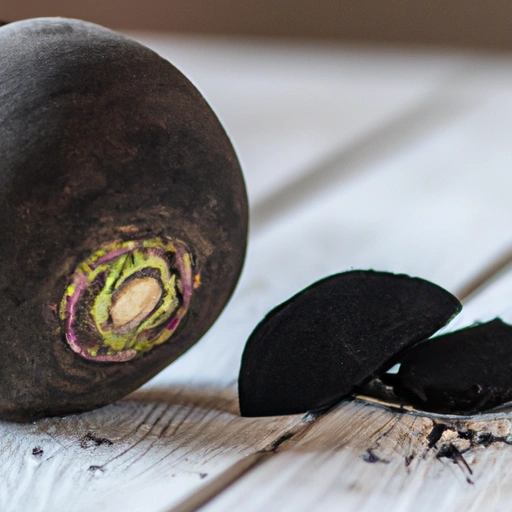Black Radish
Description

The black radish is a root vegetable known for its distinctive black or dark brown skin and crisp, white flesh. This earthy, peppery flavored ingredient varies in size but generally resembles a large radish or turnip. The flesh of black radish is firmer than that of its red or white counterparts, making it suitable for a variety of cooking methods. It is a versatile ingredient that has been used in culinary traditions around the world, adding a sharp bite and a range of nutrients to any dish.
Common uses
Black radish is commonly eaten raw, grated or sliced in salads, or as a crunchy condiment. It can also be cooked; when roasted, sautéed, or added to soups and stews, it develops a milder, sweeter flavor. The radish's strong flavor profile makes it a popular ingredient for pickling, and it is often fermented to produce savory dishes.
Nutritional value
Calories
A 100-gram serving of black radish contains approximately 35 calories (146 kJ).
Protein
Black radish provides nearly 1.9 grams of protein per 100 grams.
Fat
This root vegetable is low in fat, with around 0.2 grams per 100-gram serving.
Carbohydrates
Black radish comprises about 6.7 grams of carbohydrates for every 100 grams, of which 2.6 grams are dietary fiber.
Vitamins
Rich in vitamin C, black radish offers about 29 mg per 100 grams. It also contains small amounts of B vitamins.
Minerals
It is a good source of minerals, including potassium (470 mg/100g), magnesium (31 mg/100g), and calcium (55 mg/100g).
Health benefits
Black radish has been linked to a variety of health benefits, including improved digestion, immune support, and detoxification of the liver. The high vitamin C and antioxidant content may contribute to better skin health and overall immune function.
Potential risks
Black radish should be consumed in moderation, as excessive consumption can lead to digestive upset for some individuals. Those with thyroid issues should also be cautious, as black radish contains goitrogens, which can interfere with thyroid function.
Common recipes
Black radish is featured in recipes such as black radish slaw, fermented radish pickles, and roasted radish side dishes. It can also be found in traditional European soups and stews.
Cooking methods
It can be enjoyed raw, roasted, sautéed, or boiled. Black radish can also be fermented or pickled for additional flavor profiles.
Pairing with other ingredients
Black radish pairs well with rich meats, creamy cheeses, and other root vegetables. It also complements the flavors of citrus, herbs, and vinegars.
Summary
Black radish is an intriguing and nutritious root vegetable that offers a unique peppery taste to a variety of dishes. Whether used raw in salads or cooked in savory meals, it provides both flavor and health benefits. With its historical significance and modern culinary applications, black radish is a valuable addition to any kitchen around the world.